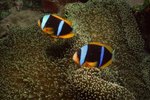Various species of each are available in the aquarium trade, but Acan and Favia corals show subtle differences in terms of appearance and needs. If you have an unidentified "brain coral," the creature very likely belongs to one of these two genera, although there are other possibilities.
Taxonomy
The genus Favia consists of a reef-building corals, commonly known as brain corals because of their often spherical, corrugated appearance. “Acan” is short for the genus Acanthastrea, a similar genus. In the aquarium world, the terms “favia” and “acan” are sometimes more generally, if incorrectly applied to the families for each, Faviidae and Mussidae respectively. Both types belong to the same order -- Scleractina, commonly known as stony corals because they all develop hard calcium carbonate skeletons.
Physical Appearance
Although considerable variation exists among the species of each genus, Acan corals have a fleshier look in general. The defining characteristic of Ancanthastrea, and indeed the entire Mussidae family, is spiky extrusions from the carbonate skeleton -- spetal teeth. You might not be able to see these but could feel them with gentle manipulation. Other variations in appearance should help to identify the exact species.
Ecology
Both genera inhabit and help to form coral reefs, getting their nutrition partly from symbiotic algae and partly through consuming microscopic creatures. In captivity, Acan, Favia and similar corals not only need water of the correct temperature and chemistry, but also sufficient light to sustain their algae. Exact water parameters and light requirements vary according to species.
Considerations
Because several species of both genera appear for sale, along with other similar-looking corals, and because they have slightly differing needs, try to get a full identification. General aquarium suppliers often misidentify their corals, sometimes not even getting the genus right; so either buy from a specialist or spend time researching the coral you have to confirm which species the creature actually is. Aquarium forums can be helpful for this purpose. With regard to conservation, some species of coral are threatened by overcollection for the aquarium trade, which is another reason to get a proper identification. Check the origin and conservation status of your chosen species before buying. Cultured are the best option; otherwise, select coral collected in a sustainable manner.
References
Writer Bio
Judith Willson has been writing since 2009, specializing in environmental and scientific topics. She has written content for school websites and worked for a Glasgow newspaper. Willson has a Master of Arts in English from the University of Aberdeen, Scotland.





